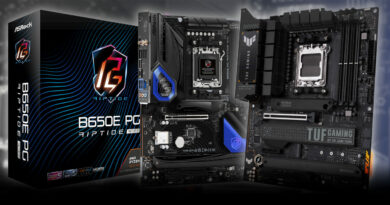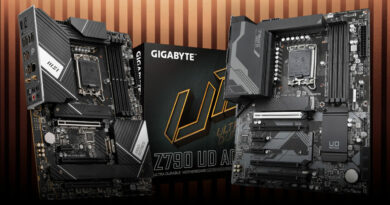Best $300’ish X870/X870E Motherboards for Gaming Builds! Buying Guide and Comparison
TalosPC is supported by its audience. We may earn an affiliate commission from qualifying purchases through links on our site.
AMD motherboard partners just release their new AMD X870 an X870E Chipset motherboards for the recently launched AMD Zen 5 Ryzen 9000 CPUs. With mandatory USB4 integration and mandatory PCIe 5.0 support for both graphics (GPU), and M.2 NVMe slot. The new motherboards are Ryzen 9000 ready, and Wi-Fi 7 support should be available on most X870/X870E motherboards.
The previous AMD 600-series chipset motherboards do have support for Ryzen 9000 CPUs (after BIOS updates), but they lack a few key features that makes the new X870 and X870E chipset motherboards interesting for a few consumers who might need them.
Previous AMD X670 chipset motherboards did not offer PCIe 5.0 support for the GPU slot, same as B650 Chipset motherboards. While the AMD B650E and X670E motherboards did offer PCIe 5.0 support for both graphics (GPU) and M.2 NVMe slot, USB4 support was optional, and only found in a few motherboards (usually on more expensive flagship models). Wi-Fi 7 support was not widely adopted yet and it rare on 600-series chipset motherboards.
- If you want a PCIe 5.0 gaming build, but USB4 support is not necessary, consider getting a PCIe 5.0 B850 Chipset Motherboard instead, as they offer similar features and specifications, but a lower price point.
Prices for the new motherboards start at around $200, with the ASRock X870 Pro RS and X870 Pro RS WiFi being prime examples of excellent motherboards for gaming builds. But for those who require more features, faster USB, faster storage or quality of life features for DIY builds, such as quick release and screwless designs, 7-segment displays for quick troubleshooting etc, the $300+ range would be the best place to start looking.
If you are looking for a new motherboard with latest technology and features, support for USB4, PCIe 5.0 and Wi-Fi 7 (especially Wi-Fi 7 11be 320MHz), the new X870 and X870E motherboards are a must have. To make choosing the right motherboard for your gaming build a little easier, we have a (not so quick) breakdown and comparison of some of the best X870 and X870E motherboards available in the $300-350 range!

MSI MAG X870 TOMAHAWK WIFI
With a gaming build in mind, the MSI MAG X870 TOMAHAWK WIFI is our personal favorite. It is one of the best solutions for those looking to have the latest technology on their AM5 gaming builds. It offers Wi-Fi 7 (11be 320MHz), dual M.2 PCIe 5.0 x4 slots, USB4 connectivity and quality of life features for DIY builds.
The PCIe 5.0 x16 slot and all M.2 slots are equipped with quick release and screwless designs (MSI EZ PCIe Release and EZ M.2 CLIP II). Top and bottom M.2 slot heatsinks are screwless (MSI EZ M.2 Shield Frozr II).
Two of the M.2 slots (M.2_1 and M.2_2) are PCIe 5.0 x4, and the other two are PCIe 4.0, one being x4 (M.2_4) and the other x2 (M.2_3). Full USB4 capabilities are only available when M.2_2 is not in use.
- Both USB4 and M.2_2 can operate at the same time at PCIe 5.0 x2 mode, or M.2_2 can be set to PCIe 5.0 x4 mode, but that will disable USB4 ports
Key points and comparisons:
- PCIe (GPU) and M.2 slots with quick release and screwless Design (MSI EZ PCIe Release and EZ M.2 CLIP II)
- Two M.2 heatsinks with screwless design (MSI EZ M.2 Shield Frozr II). Heatsink for the other M.2 slots is fixed using screws.
- Wi-Fi 7 module with 11be 320MHz wireless standard and 5Gbps LAN.
- M.2_2 (PCIe 5.0 x4) and USB4 sharing bandwidth could be interesting for those who only need one of the two.
- M.2_3 slot only runs at PCIe 4.0 x2 mode.
- All four M.2 slots can be used without limiting GPU bandwidth. Other X870/X870E will either limit bandwidth to PCIe 3.0 x2 (like on the ASUS Prime X870-P WiFi), or cost a lot more than the MSI model.
- $349.99 ASRock Phantom Gaming X870E Nova WiFi and 399.99 ASRock X870E Taichi Lite, are the “cheapest” examples.
- In it’s price range, considering a gaming build, it’s one of the best motherboards for those who want WIFI7 320MHz support, lots of M.2 storage, GPU performance (x16) and either some, or full USB4 capabilities (Unless all four M.2 slots are in use).
Recommended for:
- High-end gaming builds with Wi-Fi 7 (320MHz) support, four usable M.2 slots (with GPU at x16 bandwidth), or the option of full USB4 capabilities (with 3x M.2 in use).
- DIY builds, with hassle-free access to GPU and M.2 devices and a few M.2 heatsinks (Quick release and screwless design)
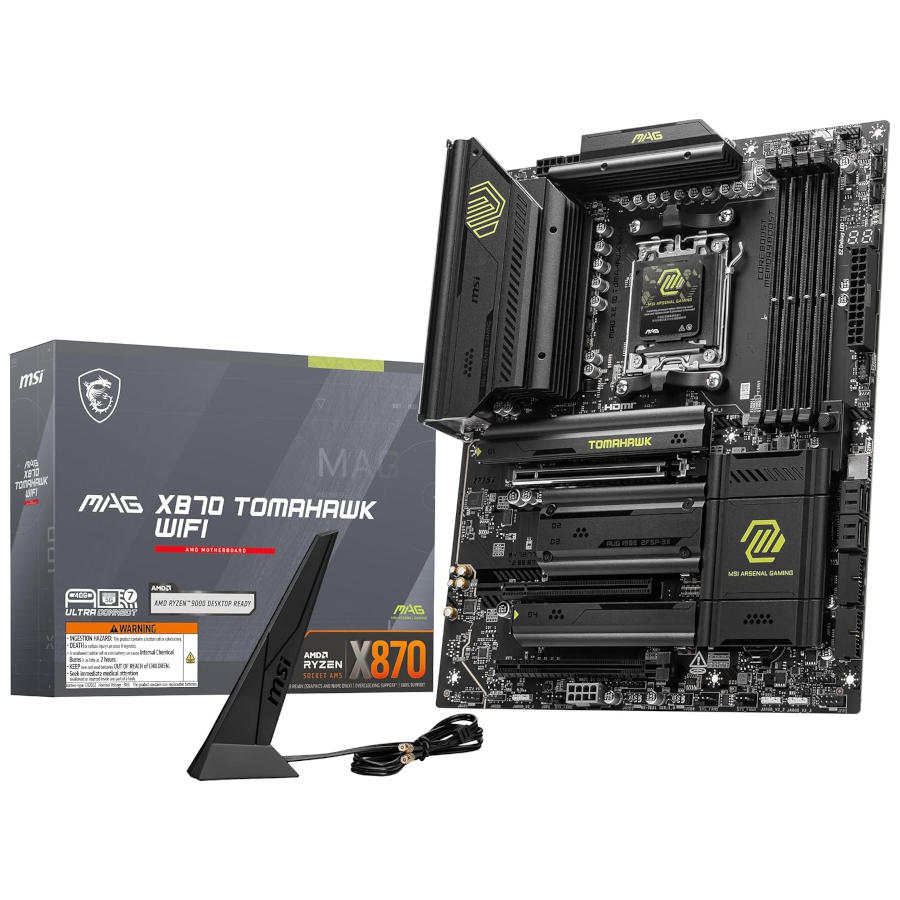
| Pros: | Cons: |
|---|---|
| 1. Wi-Fi 7 (11be 320MHz) support 2. 3x USB Type-C on rear I/O (2x USB4 and 1x USB 3.2 Gen2) 3. 7-segment display (Debug Code display) 4. Internal USB Type-C Header, with USB 3.2 Gen 2×2 support; 5. Support for up to 4x USB 3.2 Gen1 Type-A (2x USB 3.2 Gen 1 internal headers) 6. 8-Layer PCB Design 7. Support for up to 2x M.2 PCIe 5.0 x4 slots 8. All four M.2 slots can be use without limiting PCIe 5.0 x16 9. 5Gbps LAN 10. Overkill VRM. | 1. One of the M.2 slots (M2_3) is limited to PCIe 4.0 x2 bandwidth (The MSI MAG X870E TOMAHAWK WIFI M.2_3 slot run at PCIe 4.0 x4) 2. USB4 and M2_2 slot (PCIe 5.0 x4) shares bandwidth. Both can be used at the same time in x2 mode, or either at x4, with the other disabled. 3. For those who don’t have any use for Wi-Fi 7 or USB4, consider getting a B650E or X670E motherboard instead. 4. The MSI MAG X870E TOMAHAWK WIFI is close in price, and M.2_3 run at PCIe 4.0 x4, instead of x2 (X870). |
Specifications:
- 14+2+1 Power Stages (80A)
- 5GbE LAN & Wi-Fi 7 (320MHz)
- PCI Express 5.0 Support
Storage:
- 4x M.2 Slots
- 2x M.2 PCIe 5.0 x4 slot
- 1x M.2 PCIe 4.0 X4 slot
- 1x M.2 PCIe 4.0 X2 slot
- 2x SATA 6Gb/s
USB Rear I/O:
- 2x USB4 (Type-C)
- 1x USB 3.2 Gen2 (Type-C)
- 2x USB 3.2 Gen2
- 3x USB 3.2 Gen1
- 4x USB 2.0
Internal USB Header:
- 1x USB 3.2 Gen2x2 (Type-C)
- 2x USB 3.2 Gen1 headers (Supports 4x USB 3.2 ports)
- 2x USB 2.0 headers (Supports 4x USB 2.0 ports)

GIGABYTE X870 AORUS ELITE WIFI7 and X870 AORUS ELITE WIFI7 ICE
GIGABYTE X870 AORUS ELITE WIFI7 and the GIGABYTE X870 AORUS ELITE WIFI7 ICE are the “entry level” options into GIGABYTE AORUS lineup. They come with excellent quality of life features, such as PCIe and M.2 slots with Quick Release and Screwless Design (EZ-Latch Plus), M.2 heatsinks with screwless design (EZ-Latch Click) and Wi-Fi antenna plugs integrated into one adapter (WIFI EZ-Plug)
The X870 AORUS ELITE has a focus on USB4 connectivity and PCIe 5.0 storage, with 3x M.2 PCIe 5.0 x4 slots, two of which (M2B_CPU and M2C_CPU) share bandwidth with the GPU slot, meaning the GPU PCIe slot will be limited to x8 speeds if any of those two M.2 slots are in use. The motherboard has a fourth PCIe 4.0 x4 M.2 slot (M2D_SB), integrated to the chipset, sharing bandwidth with the PCIe 4.0 x4 Slot (only one is available at a time). Wi-Fi 7 uses the 11be 160MHz standard.
Key points and comparisons:
- PCIe (GPU) and M.2 slots with Quick Release and Screwless Design (GIGABYTE EZ-Latch Plus).
- M.2 heatsinks with screwless design (GIGABYTE EZ-Latch Click).
- USB4 controller does not share bandwidth with any other slot/connector (Unlike the MSI MAG X870 TOMAHAWK WIFI)
- Only two M.2 slots can be used without limiting the GPU PCIe slot to x8 bandwidth.
- ASUS TUF Gaming X870-PLUS WiFi can have 3x M.2 slots in use.
- MSI MAG X870 TOMAHAWK WIFI can have all 4x M.2 slots in use.
- ASRock X870 Motherboards can have all 3x M.2 slots in use.
- Cheapest motherboard with support for 3x M.2 PCIe 5.0 x4 slots.
- Cheapest X870/X870E motherboard to offer a 7-segment display.
- Wi-Fi 7 uses the 11be 160MHz standard. MSI offers 11be 320MHz wireless in the cheaper MSI PRO X870-P WIFI and the MAG X870 TOMAHAWK WIFI.
Recommended for:
- High-end gaming builds with USB4 and PCIe 5.0 support… That don’t mind only two usable M.2 slots (without limiting GPU slot bandwidth).
- Those who prioritize a lot of PCIe 5.0 M.2 storage and USB4, over GPU performance.
- DIY builds, with hassle-free access to GPU and M.2 devices and M.2 heatsinks (Quick release and screwless design)
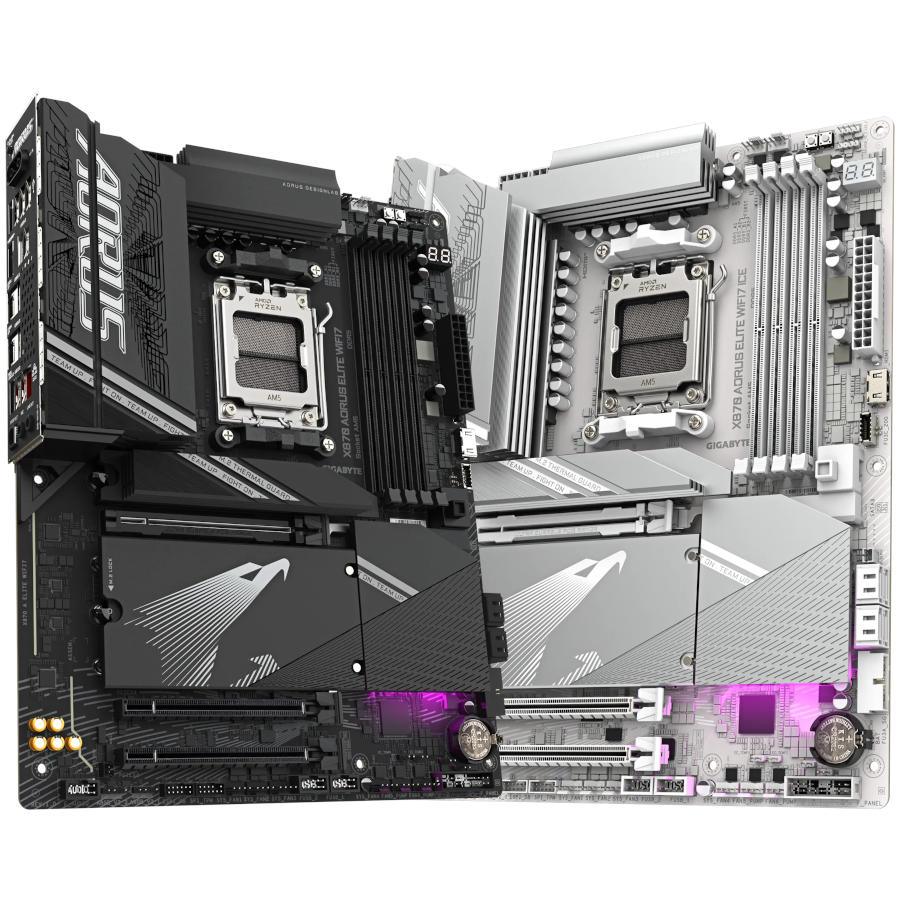
| Pros: | Cons: |
|---|---|
| 1. PCIe (GPU), M.2 slot and M.2 heatsinks with Quick Release / Screwless Designs. 2. Dual USB4 USB Type-C ports, 4. Internal USB Type-C Header, with USB 3.2 Gen 2×2 support; 5. 7-segment display (Debug Code display); 6. All-White option; 7. Support for up to 3x M.2 PCIe 5.0 x4 slots (with GPU PCIe slot in x8 mode) 8. All M.2 slots are PCIe x4 bandwidth. 9. Overkill VRM. | 1. M.2 slots M2B_CPU and M2C_CPU share bandwidth with the PCIe X16 Slot. The PCIe 5.0 X16 slot will run at X8 speeds if either one of those M.2 Slots are occupied; 2. Only two M.2 slots (M2A_CPU and M2D_SB) can be used if full X16 bandwidth for GPU is required; 3. PCIEX4 shares bandwidth with M2D_SB, only one can be used at a time; 4. Only one USB 3.2 Gen 1 (Type-A) internal header (Supports up to 2x Type-A ports). 5. Wi-Fi 7 11be 160MHz.MSI uses 11be 320MHz on it’s lineup, starting with the $240 MSI PRO X870-P WIFI 6. For those who don’t have any use for Wi-Fi 7 or USB4, consider getting a B650E or X670E motherboard instead. You will find up to 4x usable M.2 slots on X670E motherboards |
Specifications:
- 16(8+8)+2+2 Power Stages (60A)
- 2.5GbE LAN & Wi-Fi 7 (320MHz)
- PCI Express 5.0 Support
Storage:
- 4x M.2 Slots
- 3x M.2 PCIe 5.0 x4 slot
- 1x M.2 PCIe 4.0 X4 slot
- 4x SATA 6Gb/s
USB Rear I/O:
- 2x USB4 (Type-C)
- 2x USB 3.2 Gen2
- 4x USB 3.2 Gen1
- 4x USB 2.0
Internal USB Header:
- 1x USB 3.2 Gen2x2 (Type-C)
- 1x USB 3.2 Gen1 headers (Supports 4x USB 3.2 ports)
- 2x USB 2.0 headers (Supports 4x USB 2.0 ports)

ASUS TUF Gaming X870-PLUS WiFi
The ASUS TUF model offers great quality of life features for DIY builders, with PCIe slot quick release button (Q-Release), toolless and screwless M.2 locking mechanism (Q-Latch) and locking mechanism for the Wi-Fi antenna (Q-Antenna).
The motherboard has a focus on USB4, GPU performance and fast storage. Two PCIe 5.0 x4 slots are available (M.2_1 and M.2_2). M.2_2 shares bandwidth with the GPU PCIe 5.0 x16 slot (GPU will run x8 speeds if M.2_2 is in use). Another two PCIe 4.0 x4 slots are available (M.2_3 and M.2_4), with M.2_4 sharing bandwidth with the bottom PCIe 4.0 x4 slot (only one can be used at a time)
Key points and comparisons:
- PCIe (GPU) and M.2 slots with quick release and screwless Design (ASUS Q-Release and Q-Latch).
- All heatsinks are fixed using screws.
- 3 out of 4 M.2 slots can be populated without limiting GPU bandwidth (one more than GIGABYTE X870/X870E AORUS motherboards).
- USB4 controller does not share bandwidth with any other slot/connector (Unlike the MSI MAG X870 TOMAHAWK WIFI)
- No 7-segment display. You will find that on the MSI MAG X870 TOMAHAWK WIFI and GIGABYTE X870/X870E AORUS motherboards.
- Less PCIe expansion than the similarly priced GIGABYTE X870E AORUS ELITE WIFI7, due to less PCIe lanes (X870 vs X870E).
- Offers the best balance of M.2 storage, USB4 and GPU performance for a gaming build
- Only three out of four M.2 slots have included heatsinks.
- Wi-Fi 7 uses the 11be 160MHz standard. MSI offers 11be 320MHz wireless in the cheaper MSI PRO X870-P WIFI and the MAG X870 TOMAHAWK WIFI.
Recommended for:
- High-end gaming builds with USB4 and PCIe 5.0 support, that need at least three usable M.2 slots (with GPU slot at x16 bandwidth).
- DIY builds, with hassle-free access to GPU and M.2 devices (Quick release and screwless design)
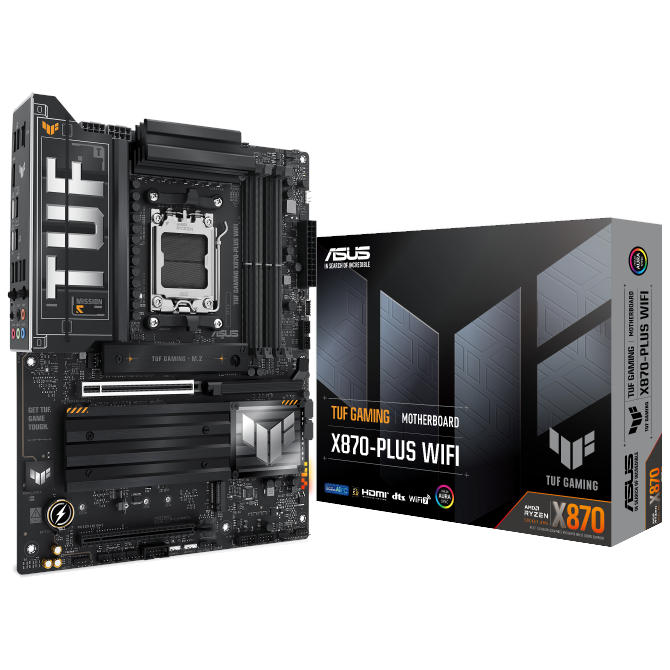
| Pros: | Cons: |
|---|---|
| 1. 3x M.2 slots (out of four) can be used if full X16 bandwidth for GPU is required; 2. PCIe (GPU) and M.2 slots with Quick Release & Screwless Design 3. Dual USB4 USB Type-C ports, 4. Internal USB Type-C Header, with USB 3.2 Gen 2×2 support; 5. 8-Layer PCB Design. 6. Overkill VRM. | 1. M.2 slot (M.2_2) share bandwidth with the PCIe X16 Slot. The PCIe 5.0 X16 slot will run at X8 speeds if M.2_2 Slots is in use; 2. Bottom PCIEX16 (PCIe 4.0 x4) slot shares bandwidth with M.2_4 slot, only one can be used at a time. 3. Only one USB 3.2 Gen 1 (Type-A) internal header (Supports up to 2x Type-A ports). 4. No 7-segment display (Debug Code display)… on a $310 motherboard 5. Wi-Fi 7 160MHz, MSI uses 11be 320MHz on it’s lineup, starting with the $240 MSI PRO X870-P WIFI 6. 3 out of 4 M.2 slots have heatsinks… on a $310 motherboard. 7. Least amount of USB Type-A ports (Compared to other ~$300 X870 motherboards). |
Specifications:
- 16+2+1 Power Stages (80A)
- 2.5GbE LAN & Wi-Fi 7 (160MHz)
- PCI Express 5.0 Support
Storage:
- 4x M.2 Slots
- 2x M.2 PCIe 5.0 x4 slot
- 2x M.2 PCIe 4.0 X4 slot
- 2x SATA 6Gb/s
USB Rear I/O:
- 2x USB4 (Type-C)
- 3x USB 3.2 Gen2
- 4x USB 3.2 Gen1
- 1x USB 2.0
Internal USB Header:
- 1x USB 3.2 Gen2x2 (Type-C)
- 1x USB 3.2 Gen1 headers (Supports 2x USB 3.2 ports)
- 2x USB 2.0 headers (Supports 4x USB 2.0 ports)

ASRock X870 Steel Legend WiFi and Phantom Gaming X870 Riptide WiFi
The ASRock X870 Steel Legend WiFi and ASRock Phantom Gaming X870 Riptide WiFi are almost perfection for gaming builds, both offer much better value than most high-end X870 motherboards, without leaving behind any features, or cheaping out on components compared to the more expensive models. If you are looking for an excellent motherboard for a gaming build, these two should be considered.
The two “main issues” both motherboards have, is the lack some DIY features, like PCIe latch (available on all other motherboards), and a fourth M.2 slot, that to be honest, only makes itself useful on the $300 MSI (Considering a gaming build, where PCIe x16 bandwidth for GPU is a priority).
Key points and comparisons:
- M.2 slots with Screwless Design and top M.2 heatsink with Quick Release.
- Best value for money high-end X870 motherboards available, starting at $259.99 MSRP for the X870 Steel Legend.
- Only three M.2 slots are available, but none of them share bandwidth with either USB4 or the GPU PCIe 5.0 x16 Slot
- Overall design is not as clean as other more expensive models.
- No 7-segment display.
- Wi-Fi 7 uses the 11be 160MHz standard. MSI offers 11be 320MHz wireless in the cheaper MSI PRO X870-P WIFI and the MAG X870 TOMAHAWK WIFI.
Recommended for:
- High-end gaming builds with USB4 support, three usable M.2 slots and PCIe 5.0 support.
- Those who want an great, but more affordable AM5 X870 platform.
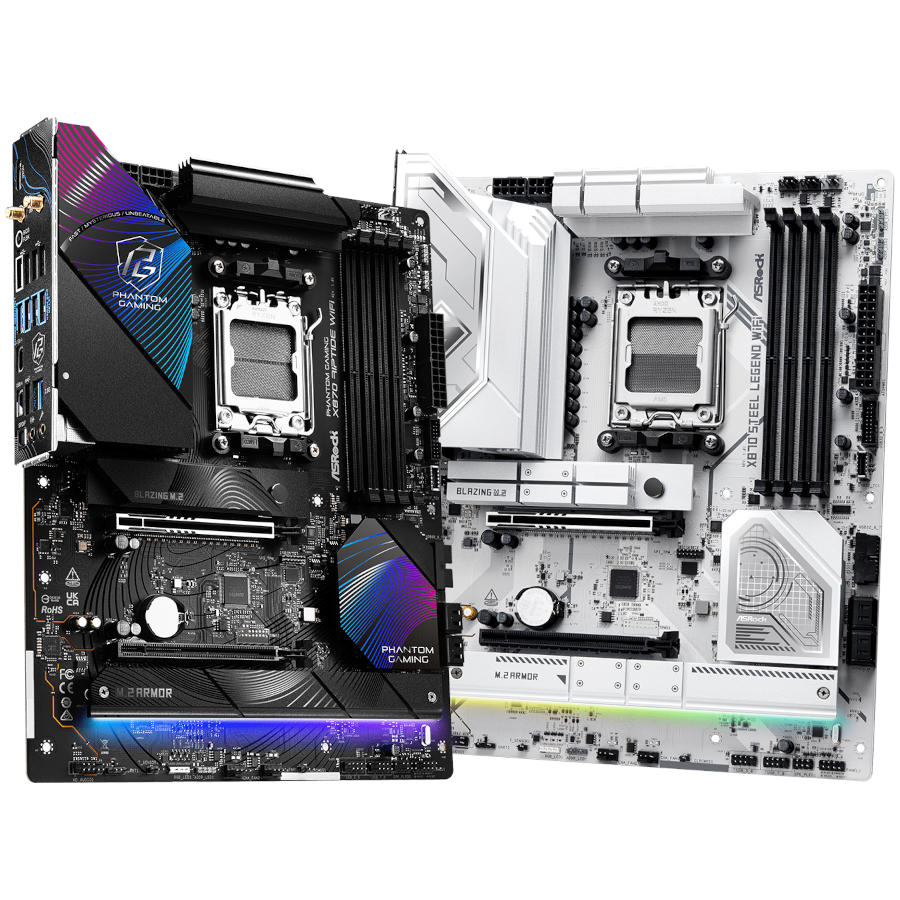
| Pros: | Cons: |
|---|---|
| 1. 8-Layer PCB Design 2. More affordable 3. Dual USB4 USB Type-C ports, 4. Internal USB Type-C Header, with USB 3.2 Gen 2×2 support; 5. Support for up to 4x USB 3.2 Gen1 Type-A (2x USB 3.2 Gen 1 internal headers) 6. All-White version 7. Overkill VRM | 1. Only 3x M.2 slots are available. 2. Wi-Fi 7 160MHz, MSI uses 11be 320MHz on it’s lineup, starting with the $240 MSI PRO X870-P WIFI 3. Support for only one M.2 PCIe 5.0 x4 slot (similar to previous X670E and B650E Motherboards) 4. No quick release on PCIe slot. 5. M2_3 slot share bandwidth with PCIE2 (PCIe 4.0 x4), only one can be used at a time. |
Specifications:
- 14+2+2 Power Stages (80A)
- 2.5GbE LAN & Wi-Fi 7 (160MHz)
- PCI Express 5.0 Support
Storage:
- 3x M.2 Slots
- 1x M.2 PCIe 5.0 x4 slot
- 2x M.2 PCIe 4.0 X4 slot
- 4x SATA 6Gb/s
USB Rear I/O:
- 2x USB4 (Type-C)
- 2x USB 3.2 Gen2
- 3x USB 3.2 Gen1
- 4x USB 2.0
Internal USB Header:
- 1x USB 3.2 Gen2x2 (Type-C)
- 2x USB 3.2 Gen1 headers (Supports 4x USB 3.2 ports)
- 2x USB 2.0 headers (Supports 4x USB 2.0 ports)

GIGABYTE X870E AORUS ELITE WIFI7 and X870E AORUS ELITE WIFI7 ICE
The GIGABYTE X870E AORUS ELITE WIFI7 improves on a few areas compared to the X870 AORUS ELITE. It is the cheapest X870E Chipset motherboard available so far, and because of that, it has more PCIe lanes to work with.
The PCIe 4.0 x4 (PCIEX4_1) connector does not share bandwidth with the M2D_SB connector anymore, meaning both can be used at the same time. A second USB 3.2 Gen1 internal header is added, and the bottom full-length PCIe connector now tops out at PCIe 3.0 x4 (X870 AORUS ELITE WIFI7 is PCIe 3.0 x2). It comes with the same quality of life features as the X870 AORUS ELITE WIFI7 motherboard, and overall, they are quite similar in specs and features.
Key points and comparisons:
- PCIe (GPU) and M.2 slots with Quick Release and Screwless Design (GIGABYTE EZ-Latch Plus).
- M.2 heatsinks with screwless design (GIGABYTE EZ-Latch Click).
- USB4 controller does not share bandwidth with any other slot/connector (Unlike the MSI MAG X870 TOMAHAWK WIFI)
- Only two M.2 slots can be used without limiting GPU PCIe slot. ASUS TUF Gaming X870-PLUS WiFi can have 3x M.2 slots in use, MSI MAG X870 TOMAHAWK WIFI can have all 4x M.2 slots in use.
- 7-segment display and support for 3x M.2 PCIe 5.0 slots.
- Bottom PCIe slots (PCIe 4.0 x4 and PCIe 3.0 x4) do not share bandwidth with other slots (compared to the X870 AORUS ELITE WIFI7).
- Wi-Fi 7 uses the 160MHz standard. MSI offers 11be 320MHz wireless standard in the MSI PRO X870-P WIFI and MAG X870 TOMAHAWK WIFI.
- All M.2 slots are PCIe x4 bandwidth.
Recommended for:
- Same recommendations as the GIGABYTE X870 AORUS ELITE WIFI7.
- Those who need the extra USB 3.2 Gen1 internal header (Compared to X870 AORUS ELITE).
- Those who have a use for the bottom full-length PCIe connectors.
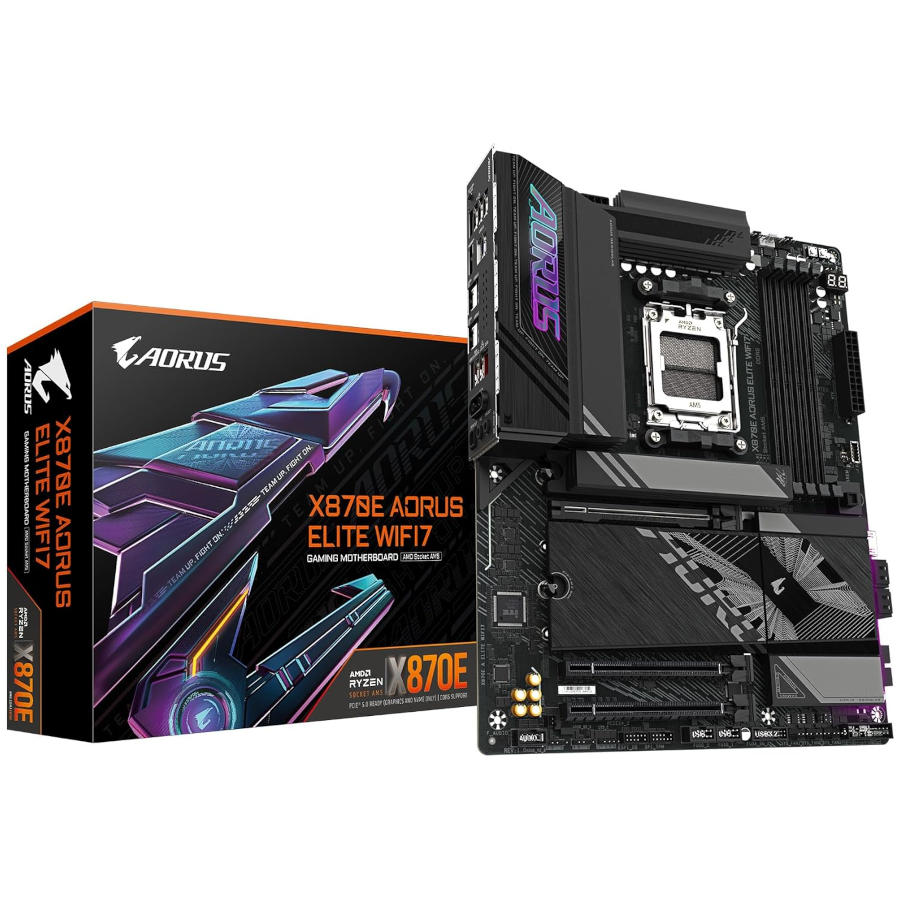
| Pros: | Cons: |
|---|---|
| 1. More attention to visuals details and aesthetics*; 2. Full-length PCIe 3.0 x4 slot, instead of PCIe 3.0 x2*; 3. Support for up to 4x Type-A USB 3.2 with additional USB 3.2 Gen 1 internal header* 4. PCIe 4.0 x4 (PCIEX4_1) and M2D_SB connector now can be used at the same time*. 5. Overkill VRM. * Compared to X870 AORUS ELITE WIFI7. Other features and specifications are very similar. | 1. M.2 slots M2B_CPU and M2C_CPU share bandwidth with the PCIe X16 Slot. The PCIe 5.0 X16 slot will run at X8 speeds if either one of those M.2 Slots are occupied; 2. Only two M.2 slots (M2A_CPU and M2D_SB) can be used if full X16 bandwidth for GPU is required; 3. Wi-Fi 7 160MHz, MSI uses 11be 320MHz on it’s lineup, starting with the $240 MSI PRO X870-P WIFI |
Specifications:
- 16(8+8)+2+2 Power Stages (60A)
- 2.5GbE LAN & Wi-Fi 7 (160MHz)
- PCI Express 5.0 Support
Storage:
- 4x M.2 Slots
- 3x M.2 PCIe 5.0 x4 slot
- 1x M.2 PCIe 4.0 X4 slot
- 4x SATA 6Gb/s
USB Rear I/O:
- 2x USB4 (Type-C)
- 2x USB 3.2 Gen2
- 4x USB 3.2 Gen1
- 4x USB 2.0
Internal USB Header:
- 1x USB 3.2 Gen2x2 (Type-C)
- 2x USB 3.2 Gen1 headers (Supports 4x USB 3.2 ports)
- 2x USB 2.0 headers (Supports 4x USB 2.0 ports)

All prices listed are MSRP launch day prices


